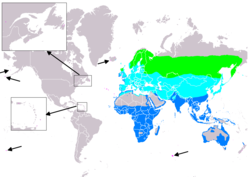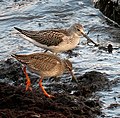| Common greenshank | |
|---|---|
 | |
| Summer plumage, Schleswig-Holstein | |
 | |
| Winter plumage, Bahrain | |
| Scientific classification | |
| Kingdom: | Animalia |
| Phylum: | Chordata |
| Class: | Aves |
| Order: | Charadriiformes |
| Family: | Scolopacidae |
| Genus: | Tringa |
| Species: | T. nebularia |
| Binomial name | |
| Tringa nebularia (Gunnerus, 1767) | |
 | |
| Range of T. nebularia Breeding Non-breeding Passage Vagrant (seasonality uncertain) | |
| Synonyms | |
| |
The common greenshank (Tringa nebularia) is a wader in the large family Scolopacidae, the typical waders. The genus name Tringa is the Neo-Latin name given to the green sandpiper by Aldrovandus in 1599 based on Ancient Greek trungas, a thrush-sized, white-rumped, tail-bobbing wading bird mentioned by Aristotle. The specific nebularia is from Latin nebula "mist". Like the Norwegian Skoddefoll, this refers to the greenshank's damp marshy habitat. [2]



